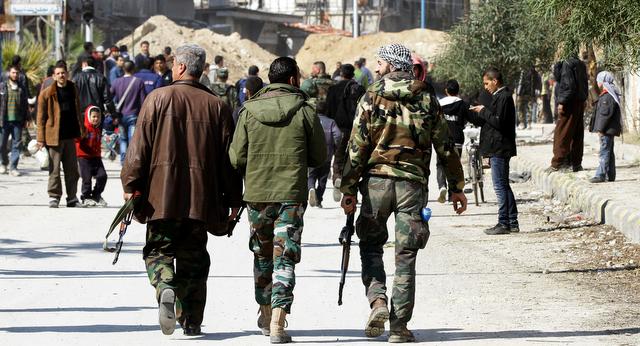Yesterday’s post looked at the Ajnad al-Sham Islamic Union, a major Damascus-based rebel coalition that has emerged in the shadow of the Islam Army of Zahran Alloush, a Salafi commander within the powerful fundamentalist alliance known as the Islamic Front.
Ideologically, the Ajnad al-Sham Islamic Union can at first appear difficult to distinguish from the Islam Army, the Islamic Front, and other Salafi-inspired factions. It is unapologetically committed to Sunni religious politics, as is the Islamic Front. The Ajnad al-Sham manifesto says that sharia law must be the only source for legislation, adding that the union’s goal is to “build the state on Islamic foundations.”
A Softer Kind of Islamism
Yet, the group distinguishes itself from hardline Salafi and jihadi groups like those of the Islamic Front in small but significant ways—for example by repeatedly stating its commitment to protecting minorities. Ajnad al-Sham’s manifesto also explains that it considers shura, or consultation, to be a mandatory step in decisionmaking. This gives the group a democratic touch and creates a religious argument against autocratic control.
While words in a manifesto do not necessarily represent realities on the ground, Ajnad al-Sham seems to prefer a type of Islamism much closer to that of the Muslim Brotherhood than that of the Gulf-based Salafi hardliners preferred by Alloush and some other Islamic Front figures (although similar to the ideology of certain Islamic Front commanders). Indeed, as Carnegie’s Raphaël Lefèvre has pointed out to me, the Der al-Asima Brigade within Ajnad al-Sham does in fact also seem to be part of the Hayat Durou al-Thawra, or the Revolution Shields Commission, a Brotherhood-backed alliance.
The Brotherhood has generally been weak in the Damascus region following a split in the 1970s, but similar ideologies have been espoused by many influential Damascene theologians, including Issam al-Attar (an elderly former Brotherhood leader now based in Germany) and Sheikh Ahmad Moaz al-Khatib (the former leader of the Syrian exile opposition’s National Coalition for the Syrian Revolutionary and Opposition Forces). In addition, a similar type of Islamism has traditionally been the political stance of much of the Damascene merchant community, perhaps giving an indication of one of the sources of support for Ajnad al-Sham.
A Zayd Group Connection?
There are signs that the Ajnad al-Sham Islamic Union, or at least some factions within it, may have links to the Zayd Group, an influential Islamic movement in Damascus that is fronted by Osama and Sariya al-Rifai, sons of the late Abdul Karim al-Rifai, a popular cleric who was forced to go into exile during the rule of former Syrian president Hafez al-Assad.
Despite, or because of, its sometimes poor relations with the Assad government, the Zayd Group was “by far the most popular religious trend in Damascus” before the uprising, according to Thomas Pierret, a Belgian scholar of Syrian Islamic politics. It has Sufi roots, although with time it has moved closer to orthodox types of Sunni Islam. While independently run, the Zayd Group now promotes a pragmatic urban brand of Sunni Islamism, which in practical politics often seems close to that of the Muslim Brotherhood.
Shabab al-Houda and Sheikh Tafour
The military commander of the Ajnad al-Sham Islamic Union, a man from Douma known as Abu Mohammed al-Fateh, belongs to the Ajnad al-Sham subfaction known as the Shabab al-Houda Battalions. This group, which some say is known for its ideological sophistication and a well-educated leadership, has grown straight out of the prerevolutionary Islamic movement in Damascus.
According to Kulluna Shuraka, a widely read Syrian opposition news site based in the United Arab Emirates, the Shabab al-Houda leadership is made up of former students of Sheikh Khaled Tafour, a Douma-based Islamic preacher in his early forties. He was not a major figure before 2011, but his movement grew after 2008. The Syrian government then began to marginalize the hitherto preeminent state-backed Islamic trend, led by the Naqshbandi Sufi disciples and descendants of Syria’s former grand mufti Ahmed Kuftaro (1915–2004) and the institutions run out of his Abu Nur Mosque in the Rukneddine neighborhood of Damascus.
A younger generation of clerics quickly sought to move into the void left when Kuftaro’s influence diminished. One of them was apparently Tafour, who exploited the state’s sudden tolerance for his group to bolster his own religious and political networks.
When the revolution began in March 2011, the sheikh took a public stand against the Assad regime, and his adherents joined street protests, only to later take up arms against the regime. Today, Tafour’s followers operate welfare institutions, Islamic studies, and a magazine under the al-Houda brand, as well as the armed wing known as the Shabab al-Houda Battalions—now a key component of the Ajnad al-Sham Islamic Union.
A Multifaceted Islamist Movement
The Damascene Islamic landscape consists of hundreds of these scholars and preachers, all with their own networks of students and followers and their own foreign contacts, upholding their personal interpretation of Islam.
With the onset of armed conflict in 2011, more moderate prerevolutionary clerics have rapidly lost influence to the austere, warlike schools of Salafism promoted by jihadi radicals and wealthy preachers in the Persian Gulf—but Syria’s indigenous Islamist traditions still remain a formidable force on the ground. It would be a grave mistake to imagine that Sunni Islamism in Syria could be neatly categorized into the best known, best organized, most violent, or most visible groups—whether that’s the Islamic Front, al-Qaeda, or for that matter the Muslim Brotherhood.






